In 2017, I published a post covering Mexico City’s ambitious new airport. At the time, readers outside of Mexico were likely unaware that Mexico City was building a new airport a few miles to the east of the city’s current overcrowded airport. The airport was extremely controversial and after over a decade of debate, protests, and even violence, construction began on what would become Mexico City’s next international airport. However, in 2019, the new Mexican president halted construction and announced that Mexico City’s new international airport would not be built on the current site. This was a popular move in the eyes of those living in Mexico City. However, the announcement did not put an end to Mexico City’s airport fiasco.
The new Mexican president, Andrés Manuel López Obrador, or AMLO, announced that the new site of Mexico City’s new international airport would be a small military installation known as Santa Lucia Air Force Base. The motivation behind moving the site of the city’s new airport was both political and financial. The new site was free of the controversy of the current site and would, according to AMLO’s government, save the Mexican government billions of dollars. However, unlike the now abandoned site of the original new Mexico City International Airport, the new site at Santa Lucia Air Force Base is far from convenient and will likely fail to address overcrowding. Nevertheless, this didn’t prevent construction and development from moving forward at the Santa Lucia site.
Why Stop Construction at The Original New Mexico City Airport Site?
Before discussing why the Santa Lucia Air Force base site makes sense, it is important to discuss why the former Texcoco site failed to make sense. The original site for Mexico City’s new airport was never all that popular among those residing in the region. However, in 2014, then-President Enrique Peña Nieto announced that the site in Texcoco would host the new airport. The site had long been the target of previous administrations when discussing the development of the new Mexico City airport. In 2002, President Vicente Fox first announced that the Mexican government now owned the site. When plans were first announced for the new Mexico City airport, violent protests broke out.
The protests of the early 2002s resulted in months of conflict. At one time, local residents, referred to by major media outlets as “peasants”, took multiple hostages and blocked numerous roads throughout the city. These protests stemmed from disputes over who rightfully held claim to the land on which the new airport would be built. The final offer made by the Mexican government included a payout of $2,850 per acre of land to those who had claimed the land. However, the Mexican government, then controlled by President Fox, ended up canceling plans for a new airport entirely.
Since the violent protests that rocked the city in the early 2000s, the new Mexico City airport project remained unpopular. Concerns about the new project moving forward resulted in the formation of the Community Front in Defense of Land. The current status of the Community Front in Defense of Land remains unclear. However, in the past, the group had been aligned with and received support from the libertarian-socialist group Zapatista Army of National Liberation or EZLN for short.
EZLN is considered a militant group by the Mexican government and has been at odds with the Mexican Government and its military since its inception in the mid-1990s.
It is quite clear why the original site for the new Mexico City airport never quite made sense. While logistically speaking, it seemed like a practical location for a new mega-transportation hub, the site’s practicality stopped at logistics.
Nevertheless, under President Enrique Peña Nieto’s government, construction began in 2014. A great deal of the airport, or rather the airport’s foundation, was built in the years following Peña Nieto’s decision to move forward with the project. Today, an outline of the airport’s terminal, runways, taxiways, and an air traffic control tower can be seen when departing the current Mexico City airport.
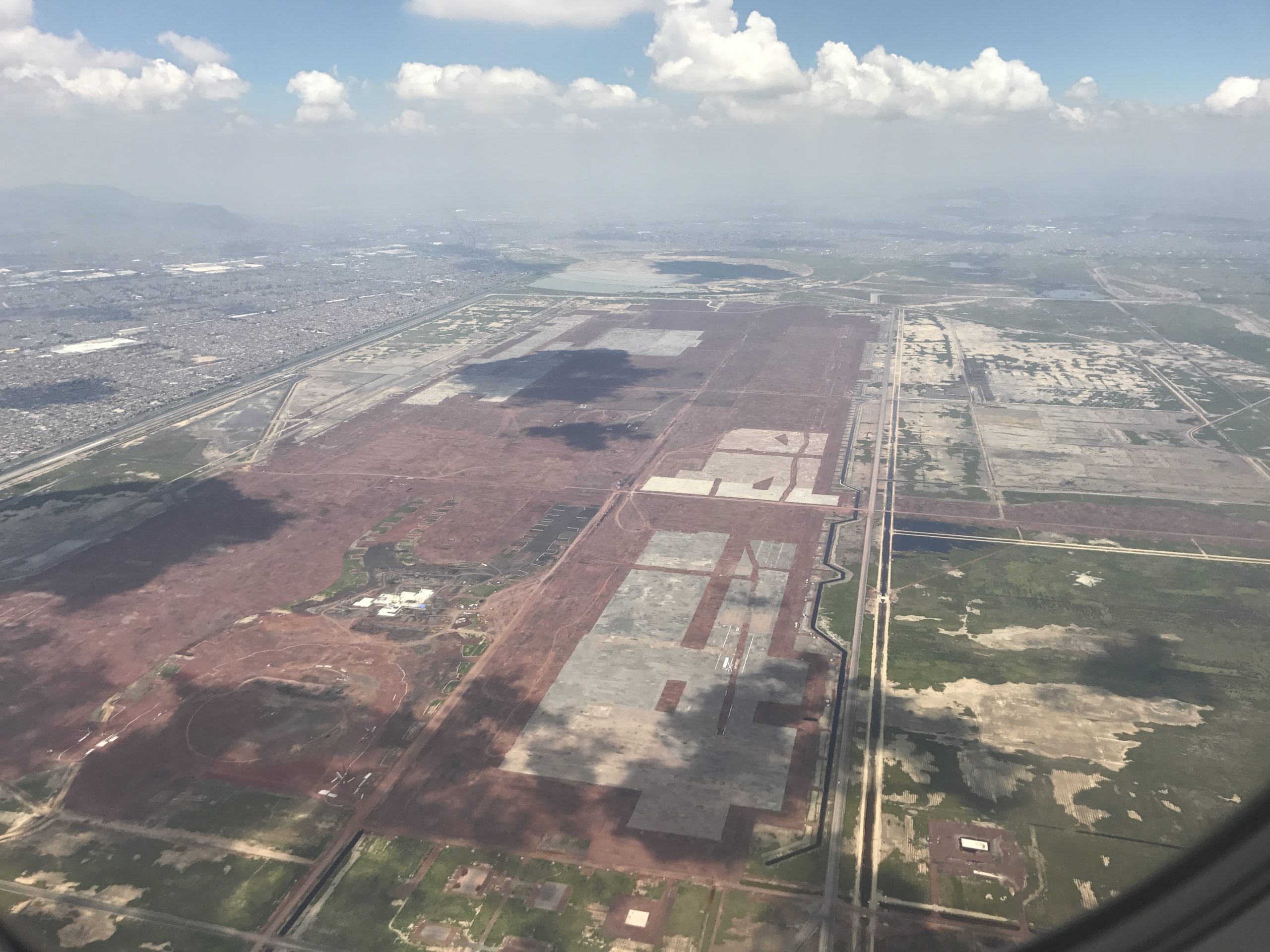
Photos: The Original Site for Mexico City’s Airport in Texcoco
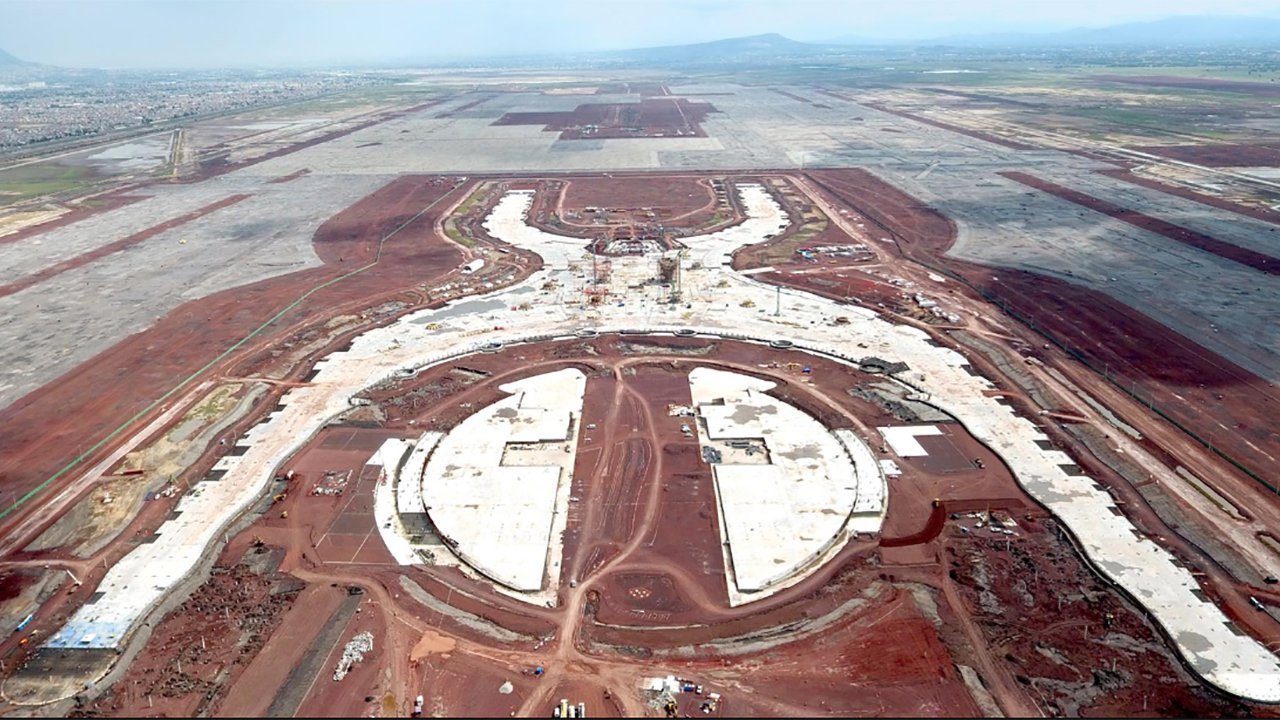
So, why did construction stop? In short, politics resulted in the abrupt end to the construction of a new airport at the Texcoco site. The political landscape in Mexico is among one of the most complicated and complex in the Americas. However, the case of the new Mexico City airport and the politics that accompany the project is rather straightforward.
The Texcoco airport site was approved and construction went forward under President Enrique Peña Nieto. President Peña Nieto is a member of the Partido Revolucionario Institucional, or Institutional Revolutionary Party in English. In American politics, the Institutional Revolutionary Party (PRI) is closer to the Democratic Party than the Republican Party. However, aspects of both American parties are evident in the PRI. Essentially, the PRI is a center to center-right big-tent party. The party, which was once the largest and most popular in the country, has lost a great deal of support as a result of numerous corruption scandals and failure to appeal to working-class Mexicans.
As a result, the left-leaning MORENA party took control of the Mexican presidency in 2018. This resulted in Mexico’s current president, Andrés Manuel López Obrador, assuming office.
Having run on a populist left-leaning platform, AMLO quickly took aim at low-hanging fruit throughout the country. One notable target of AMLO’s populist policies was the new Mexico City airport. At the time, construction was well underway at the Texcoco site. Nevertheless, construction was halted after the prospect of continued construction at the site was rejected in a non-binding referendum that had been organized by then President-elect Andrés Manuel López Obrador.
However, AMLO was not against a new Mexico City airport. Instead, the Mexican Government moved all efforts and funding away from the site in Texcoco and to a new site 27 miles north at a small military base.
Disclaimer: In the wake of recent comments from readers, I want to make it clear that this is an independent piece written by a writer with no ties to either project. We all hope that the new airport will be a success with a lasting impact on the region. However, there are aspects of the project that make it controversial. I will continue to monitor the progress of the project and will gladly report on future successes. Additionally, I encourage all readers to provide their thoughts on the project and even share new developments and information. – MP
The New Mexico City Airport: Felipe Ángeles International Airport
Construction at the Santa Lucia military base started in October 2019. Interestingly, while the private sector handled the construction at the Texcoco site, the Mexican Army was tasked with the construction at the Santa Lucia site. For the past 2 years, the Mexican military, also known as SEDENA, has been working around the clock to prepare the new airport for opening day.
As of December 19, 2021, the new airport Felipe Ángeles International Airport is set to open to commercial traffic on March 21, 2022. However, some have questioned whether or not the airport will be ready to accommodate passengers in just 3 months. Nevertheless, two airlines are ready to begin daily operations from opening day.
The following statement regarding construction at the Santa Lucia site is available on the Mexican government’s official website:
“Our budgets do not consider profits, indirect costs are very low, costs are reduced even more considering military manpower and military machinery, by virtue of having specialized personnel…”
Image: Layout of Felipe Ángeles International Airport
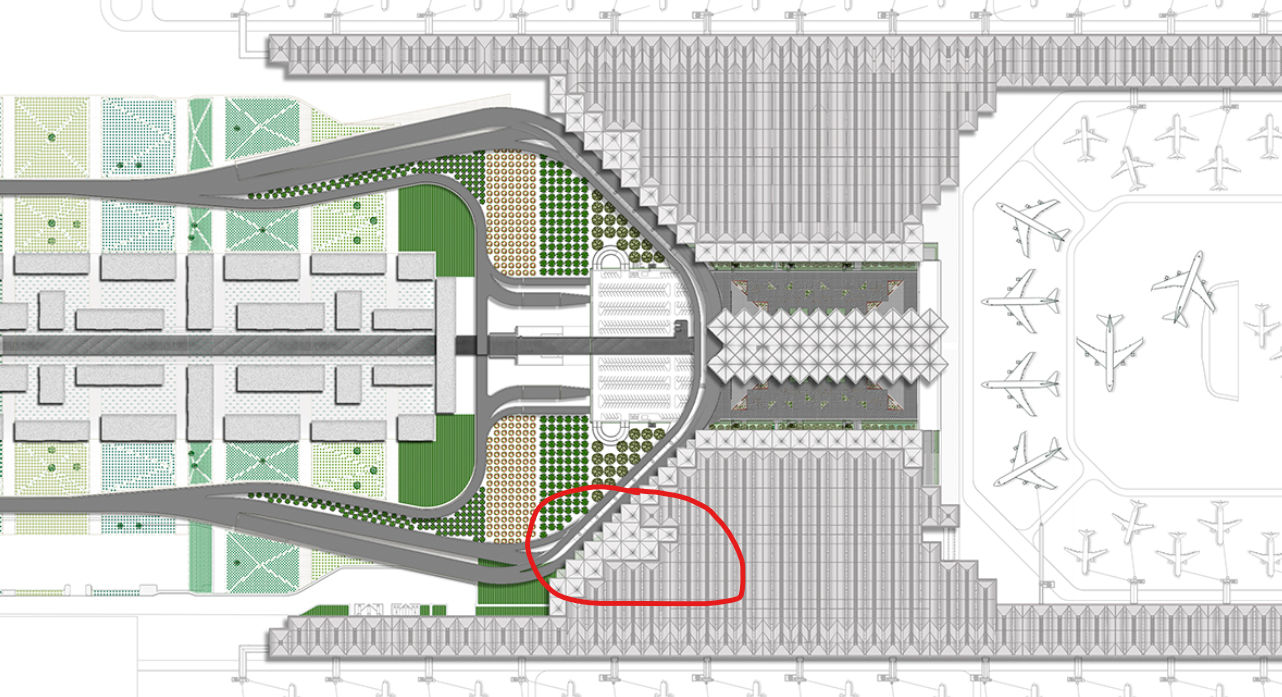
Unlike the original new Mexico City airport at the Texcoco site, the new Mexico City Airport at Santa Lucia will not serve as a total replacement for the current Mexico City International Airport. It is not entirely clear why this is the case. However, it is believed that construction plans will not immediately call for terminal space that adequately handles the volume required to replace Mexico City’s current airport. Additionally, the location of the airport is better suited to serve as a hub for low cost carriers and cargo traffic than as a replacement for operations at the current Mexico City airport.
The result is a significantly smaller new Mexico City airport with significantly reduced ambition as to what the site will eventually become. Still, the new airport will be a world-class facility.
Progress: From the Gobierno de México Official Website (from November 2021)
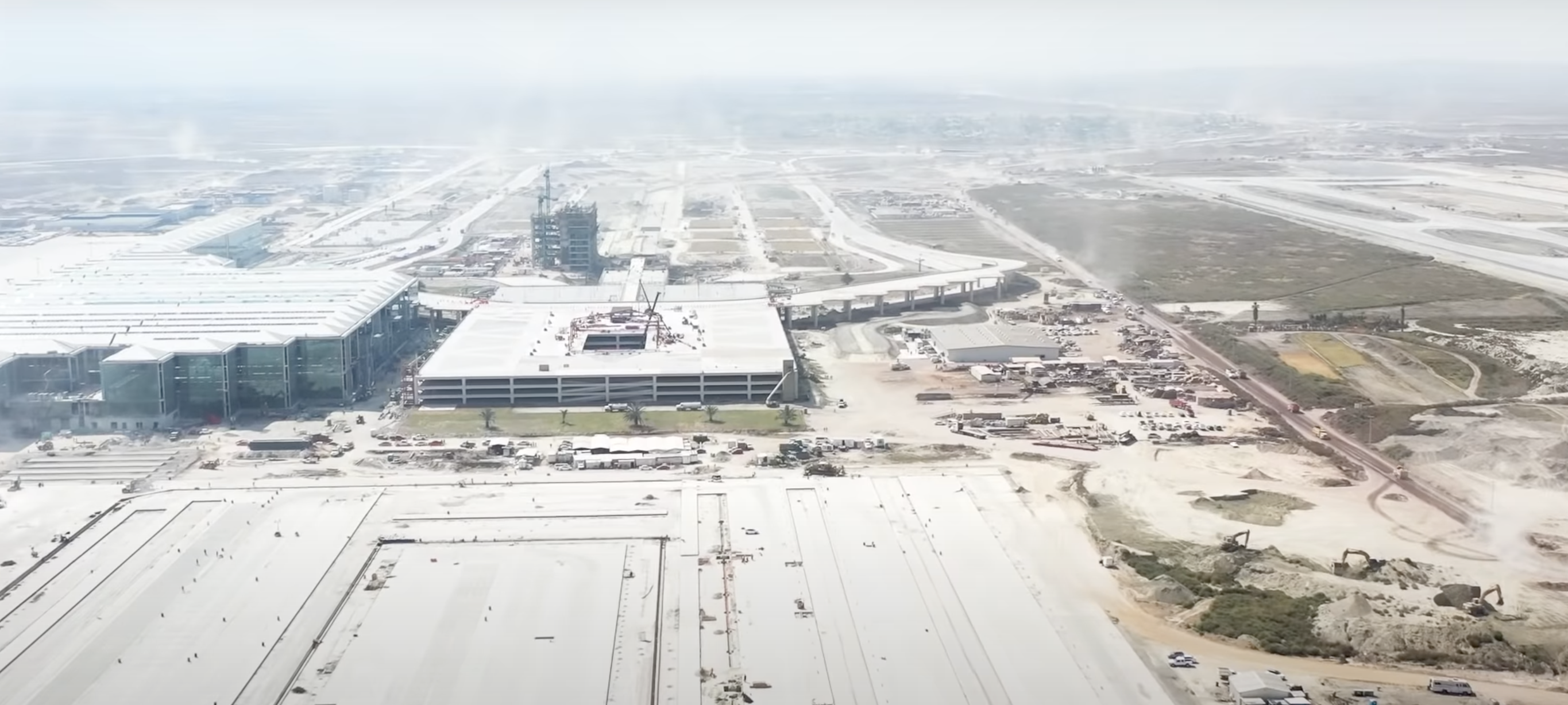
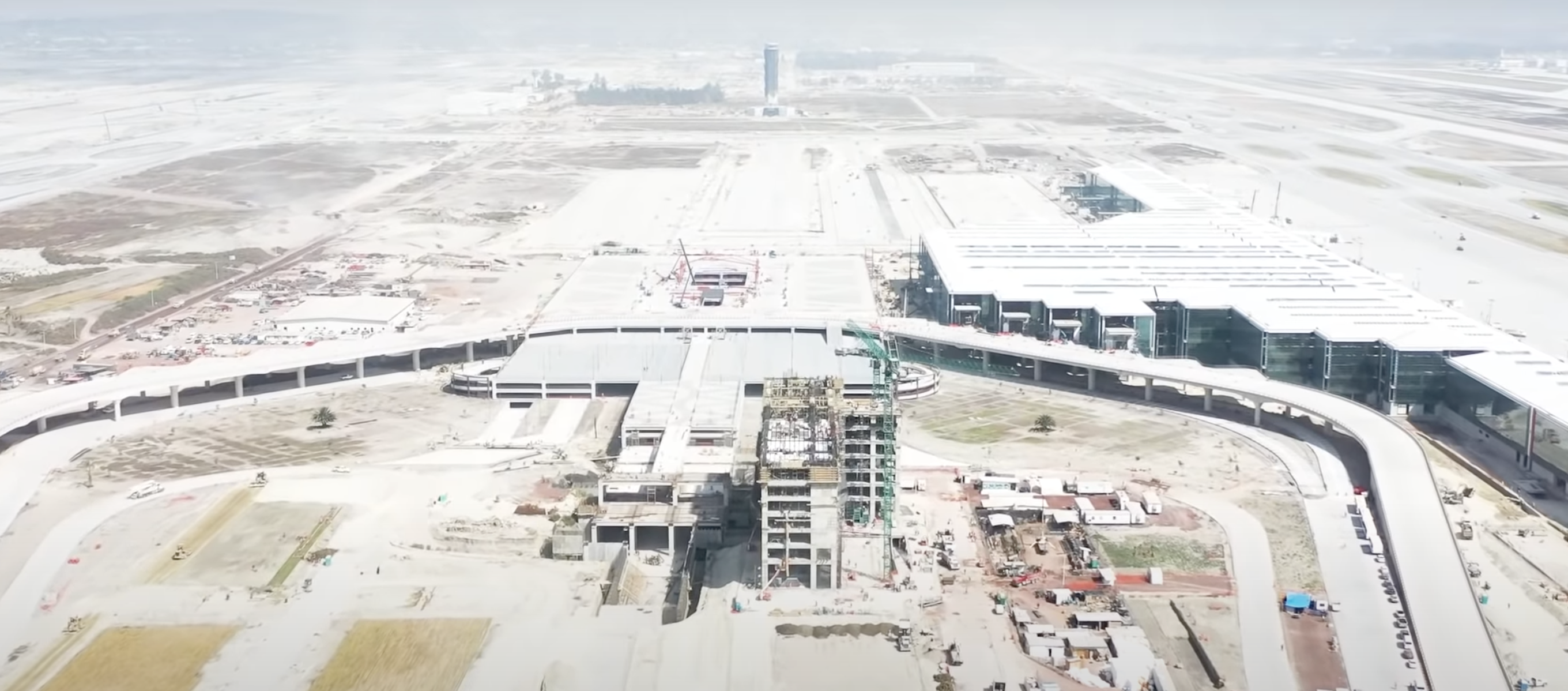
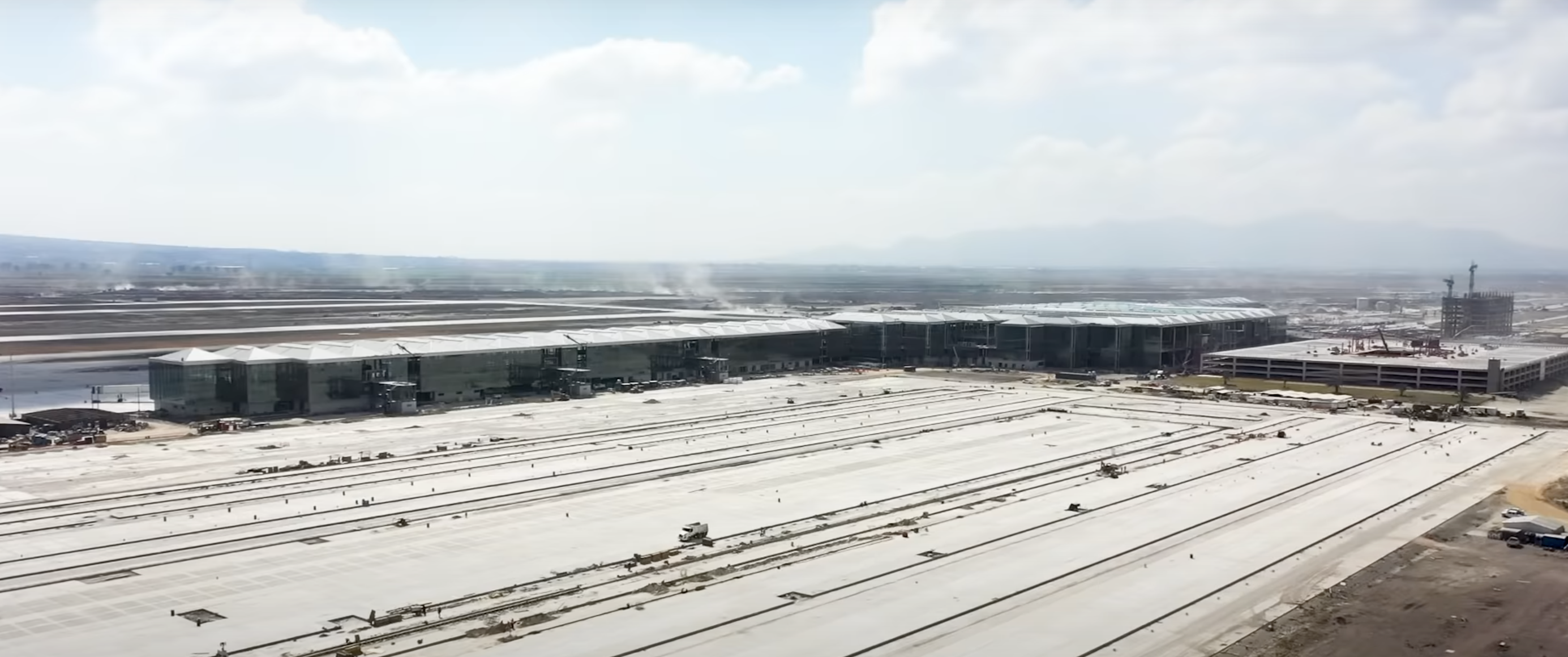
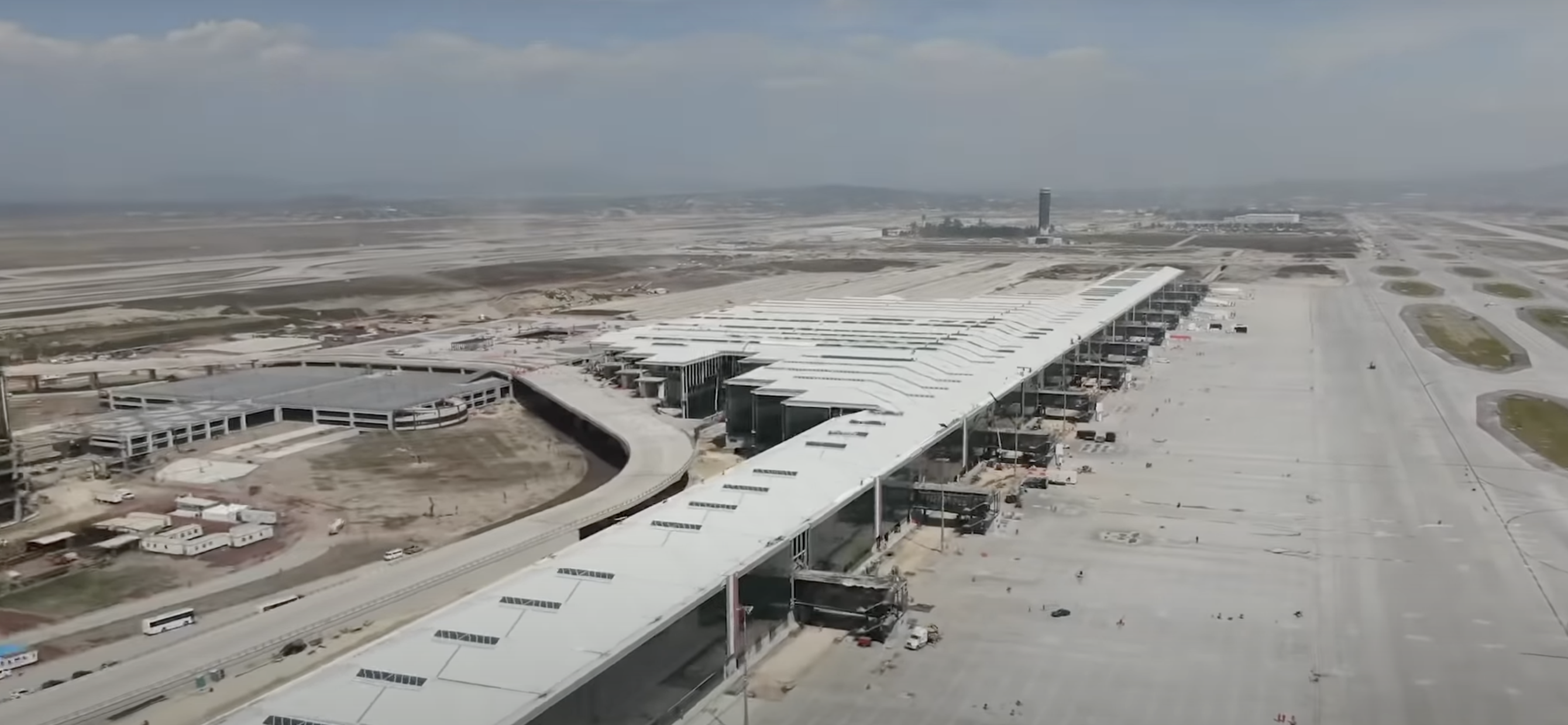
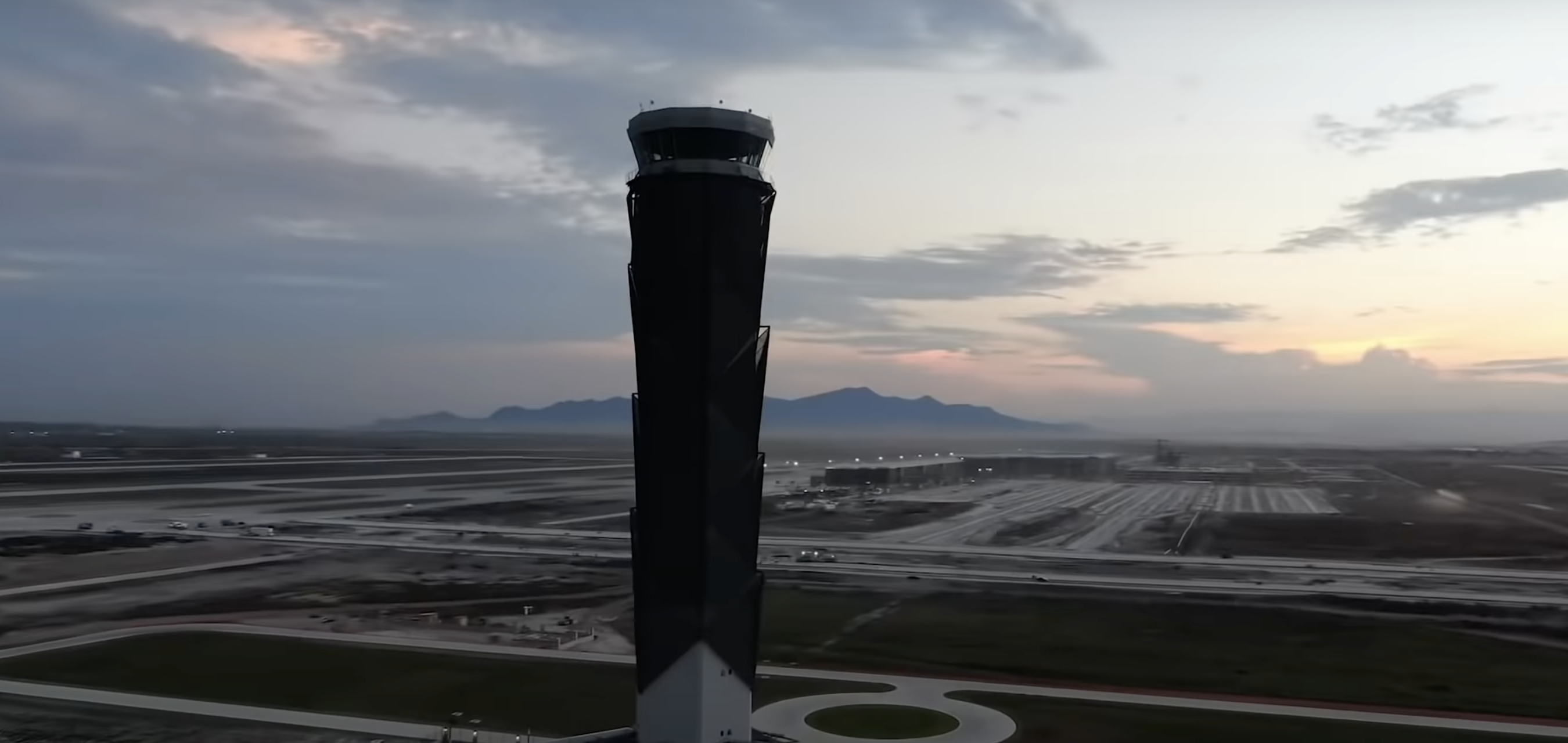
The Most Inconvenient Option for Travelers
The original site for a new Mexico City International Airport was located relatively close to the center of Mexico City. The Texcoco site was just 9.5 miles to the east of the current Mexico City International Airport. With existing public transportation infrastructure just 5 miles to the west of the Texcoco site, linking the new airport to existing public transportation would have been simple and inexpensive. For those that preferred private vehicles, the Texcoco site already bordered a major thoroughfare that gave motorists access to Mexico City’s most vital roadways. However, with the site too controversial and the new administration’s pledge to adhere to its populist agenda, easy access was not an easy selling point.
27 miles north of the Texcoco site sits the final site of Mexico City’s new international airport. However, the site also sits roughly 20 miles too far north with the nearest metro station 20 miles south at Ciudad Azteca. The site of Mexico City’s new airport is roughly 31 miles north of the city center while the site is just 7 miles from the border of the State of Mexico and Hidalgo. Travelers wishing to access the airport using a private vehicle are also out of luck with road infrastructure underdeveloped in the area.
There are multiple plans to make the new airport more accessible to both those utilizing public transit and private vehicles. However, it is unclear when these projects will be completed. As of December 2021, a new bus route is underway and should be ready by the time the airport opens in 2022. Travelers located in the heart of Mexico City and in regions like Álvaro Obregón are just as well off accessing the nearby airport in Toluca as they are accessing the new Mexico City Airport.
Travel Times: Comparing Mexico City’s Airports



I will be the first to admit, I am a gringo that lives far outside of Mexico City. Nevertheless, population statistics and transportation maps do not lie. The Santa Lucia site is far more inconvenient for those that rely on both public transportation and private vehicles when compared to both the current Mexico City International Airport and the Texcoco site. However, it is quite evident that the Texcoco site failed to respect the land rights and demands of those residing in that area.
Still, it is hard to envision a Mexico City in which anyone has to travel over an hour to reach some of the most popular and populous areas of the region. At the same time, traveling over an hour to reach the most popular or most populous areas of a city is already a reality in many cities.
Travel Times: Major US Airports to Major City Centers



Mexico City’s new airport is inconvenient for many travelers when compared to the location of the city’s current airport and the original Texcoco site. However, when compared to some of the largest cities in the United States, this inconvenience is not unheard of.
It is worth noting that these travel times are based on historic data provided by Google Maps. Therefore, the data provided by Google Maps does not take into consideration the fact that these routes will become more heavily traveled when the new airport opens. This makes public transportation projects linking the new airport to existing networks, crucial.
What March 21, 2022 Will Look Like
As of December 2021, the Mexican government still plans on opening the new airport on March 21, 2022. Assuming all of the pieces, of which there are many, come together, this is what March 21, 2022 will look like at the airport
On March 21, 2022, just two airlines will be operating out of the airport. Those airlines are VivaAerobus and Volaris. Both airlines are ultra-low-cost carriers based in Mexico. Both VivaAerobus and Volaris will serve two destinations. On opening day, the airport’s route network will consist of four destinations throughout Mexico. A fifth destination, Caracas, will be added by Venezeula’s Conviasa on May 1, 2022.
An airport is far more than just runways and terminals. For an airport to be feasible, it must be connected to the community it serves. At the moment, it is not clear whether or not infrastructure outside of the airport will be ready to handle an influx of travelers.
In a best-case scenario for the airport, assuming no additional service is added and none of the planned service at the airport ends, Felipe Ángeles International Airport can expect a maximum of 584,440 passengers in its first year of operations. Even at an average load factor of 50% per flight, the airport can expect to see around 292,200 passengers in the first year of operations. That being said, let’s use the average of 438,330 passengers in the first year.
An airport approaching 440,000 annual passengers might seem small. However, 440,000 annual passengers would place Felipe Ángeles International Airport as the 181st busiest airport in the United States and the 36th busiest in Mexico. With almost half a million passengers passing through the new airport’s terminals, significant improvements to surrounding vehicular infrastructure will be needed.
With just two airlines operating from the airport on the first day of operations, congestion might be commonplace outside of the airport. However, the area should be able to manage for some time until passenger figures begin to pick up at which time, traffic around the airport might become insufferable.
What Does The New Airport Have to Offer?
Fanfare and unique passengers amenities are to accompany any major new international airport, right? In the case of the new Mexico City airport, this is not the case. Additionally, the general public may never be sure as to what the true cost of the new airport will be. As of December 2021, one figure has been released. The new airport–terminal, and runways included–is estimated to cost just shy of $4 billion USD.
For comparison, Los Angeles International Airport’s new Midfield Concourse, an expansion of the existing Tom Bradley International Terminal (TBIT), ran up a tab totaling over $1.5 billion. Furthermore, New York-LaGuardia’s modernization which included only minor changes to the airfield cost a whopping $8 billion. Finally, the significantly larger Beijing-Daxing International Airport project is estimated to cost upwards of $20 billion.
While this might seem like a bunch of unnecessary numbers, these numbers help one to better understand the true cost of building a brand new airport. Even better, when the new Mexico City airport project was a part of private-sector efforts, plenty of costs associated with the construction of the new Mexico City airport were made available to the general public.
The total cost of the new Mexico City airport at the Texcoco site was estimated to be around $13.3 billion. However, this was for a passenger terminal that would accommodate over double the number of passengers expected to pass through Felipe Ángeles International Airport. Furthermore, one runway already existed at the site of Felipe Ángeles International Airport. Ultimately, considering that construction costs, especially those involving public entities, are highly variable, the true cost of the new Mexico City Airport might never come to light.
AMLO has responded to concerns over the cost of construction at the Santa Lucia site stating that “We have nothing to hide. We’re not like the conservatives.” Since his remarks, the total cost of the airport has been cited as totaling around $4 billion.
So, what will passengers get for $83 billion pesos (~$4 billion USD)? Unfortunately, not much about the passenger facilities have been made available. As of late 2021, what is known is that there will be a somewhat swanky new passenger terminal that can accommodate around 20 million passengers annually. There will be a parking structure, and eventually, a connection to public transit. Since the airport will primarily serve as a hub for low-cost carriers, amenities will likely be that of the typical international airport.
Here are two of the renderings of the new airport’s interior that are available to the public:
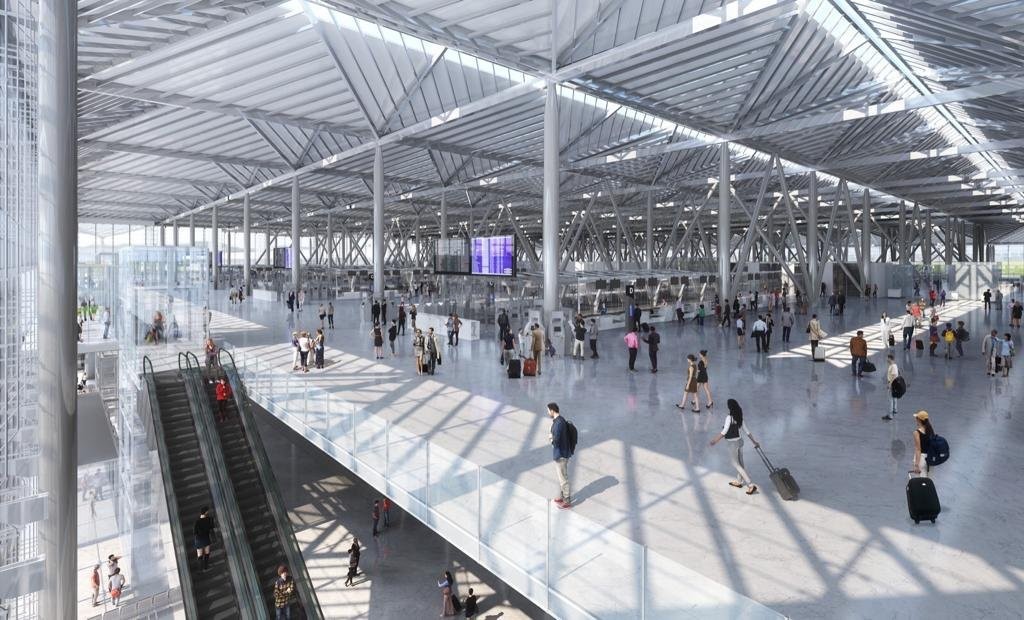
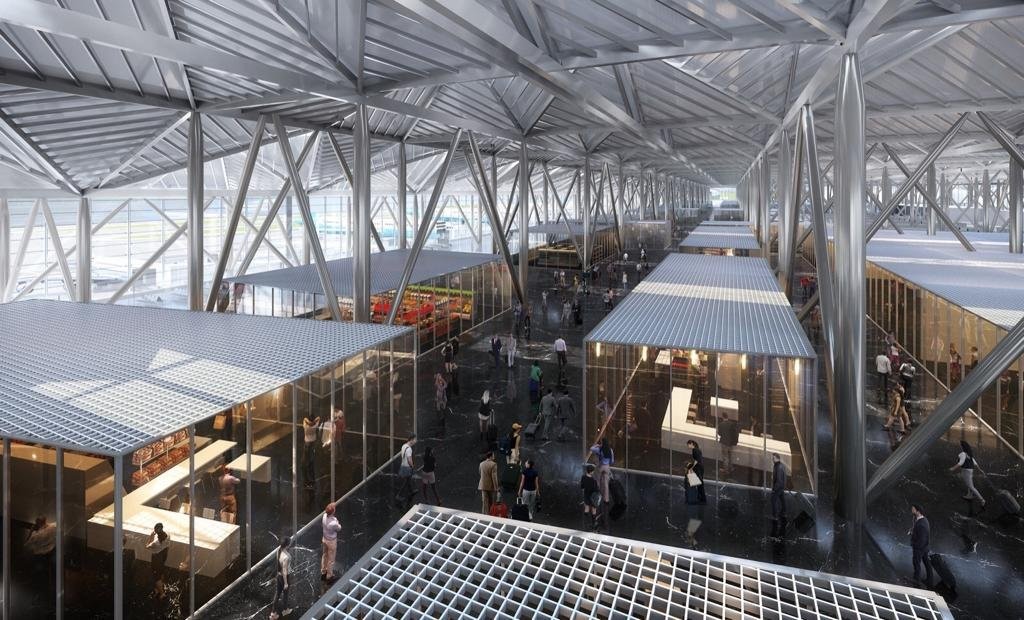
There is not much else to be said of the new passenger terminal. There is no doubt that it will be a massive improvement when compared to the current facilities at the current Mexico City International Airport. However, the new airport will likely pale in comparison to projects in neighboring countries. It will likely fail to ooh and ahh passengers. Still, it will be better than the alternative.
The Bottom Line
Mexico City’s new international airport is just three months away from opening its doors to passengers. However, there are still a lot of questions and uncertainties surrounding the new airport. While the new airport is being built on a site that has appeased the public, its $4 billion price tag appears to leave a lot to be desired. For one, the airport will not serve as a replacement for the existing Mexico City International Airport. Rather, the new airport is designed to complement the existing overcrowded airport. Furthermore, much of the outside infrastructure needed to operate a successful airport is still up in the air.
For now, the Mexican government has assured the public that the new airport will be ready for opening day on March 21, 2022. Nevertheless, the project appears to be months away from completion if not years considering the current state of the infrastructure surrounding the airport.
What do you make of the new Mexico City airport? Are you looking forward to opening day at the airport?
Featured image contains media from the Government of Mexico




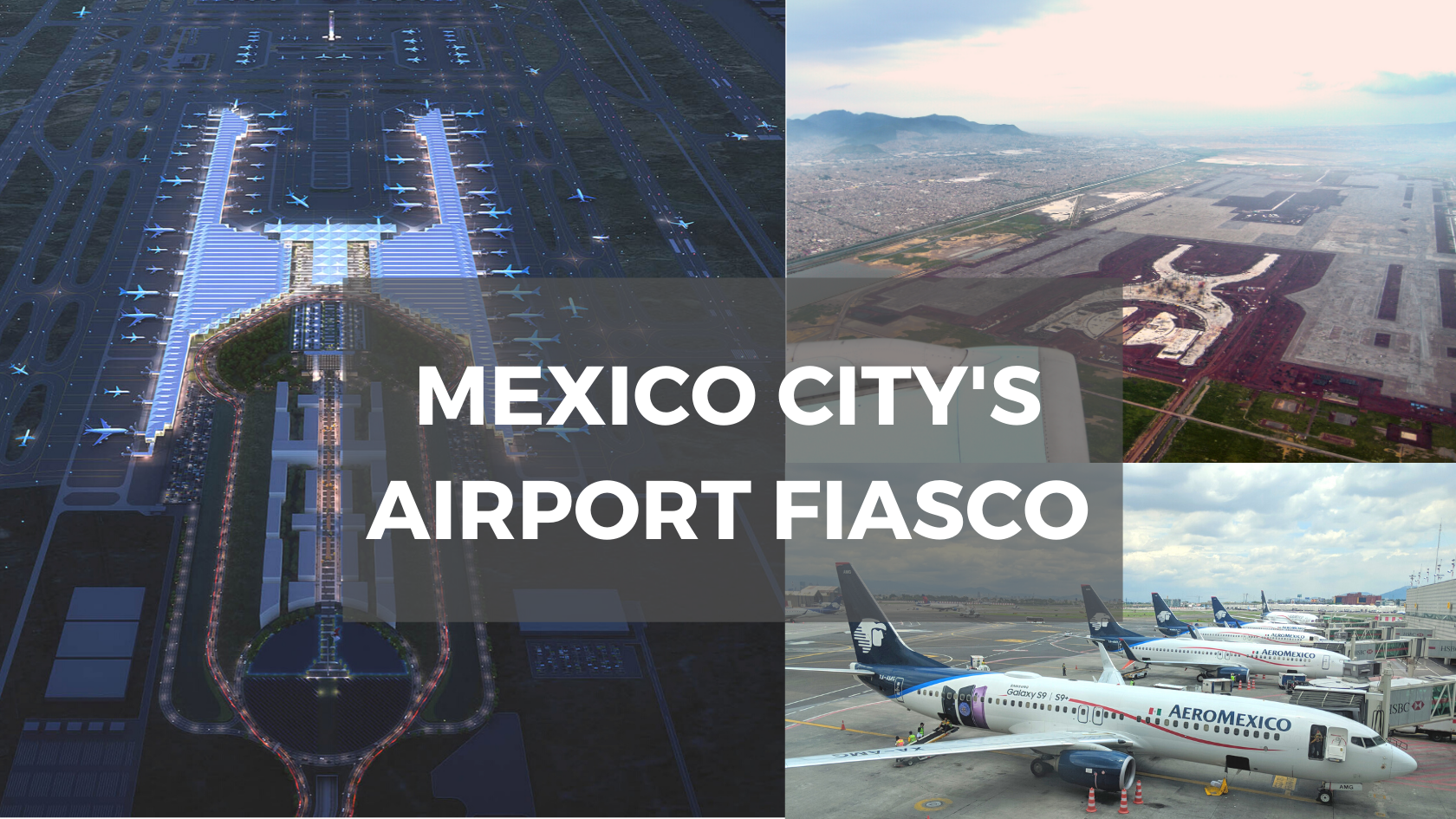
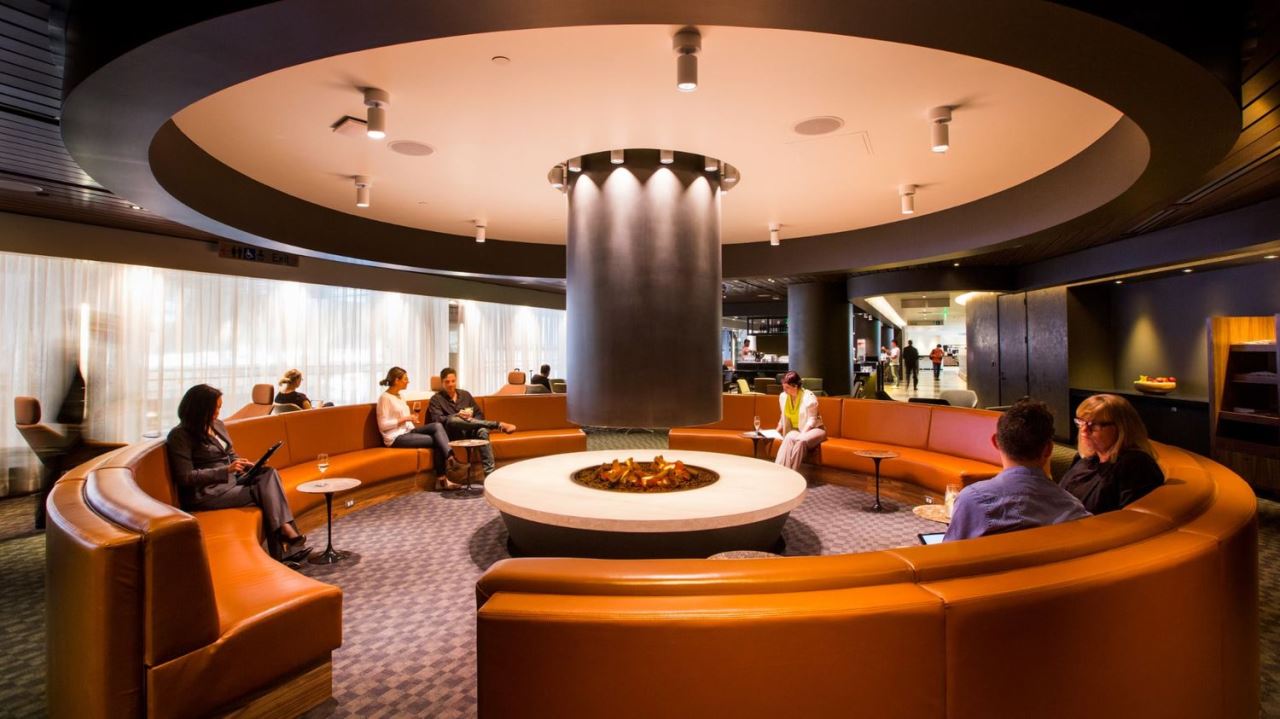







A few corrections:
1. Yes, the people that didn’t want the original airport from fox administration were peasants because those lands were agricultural lands.
2. The person that promoted lies and subversive actions those times was the one that is president now, AMLO.
3. Texcoco is a big territory, the people living in urban areas wanted airport, who are not the same that were protesting.
4. That ballot where AMLO asked people to cancel airport wasn’t made in Mexico city, so you can’t say that it was unpopular, not even made in Texcoco but far away in southern frontier.
A) To all ignorant Chairos that repeat the same bullshit and lies:
You never cared about environment, you voted for an asshole who destroyed more in rainforest in Tabasco and Quintana Roo devastating nature, and you say you care about a lake that doesn’t exist and is only full of garbage.
B) santa Lucia is also in former lake territory, so it will sink too, and mainly most of the city is in a lake, so the same logic would need to e applied to all city.
C) you don’t even pay taxes, you shouldn’t even give your opinions.
Hi Max, I believe your note Is awful and misleading. You miss to mention that previous new aiport inTexcoco was being built on a lake! Now in terms of journey duration to present airport, It depends of many variables, most importantly, traffic! It takes me over three hours from Toluca City, at only 50 km west México City. If You go by public transport allow an extra hour. So, you need yo improve your research ir Change your sources.
Octavio
The new airport will eventually get more airlines to use it, if not the government will decide who uses which airport. The old airport is very noisy for a large population close by.
The new airport can handle cargo flights and many of the point to point destinations who don’t need connectivity and it’s still close to the city. Mexicas are never in s hurry they don’t mind if coming & going to the airport takes a little more time!
Deso hacer observaciones importantes, no para usted que se presume periodista independiente, lo hago, para el público, los amigos y visitantes que visitaran México. Lamento su falta de información real, veraz al escribir su artículo, tal vez , si la vonozca y lo veo tendencioso, no real y menos objetivo..
Usted debe de saber que todo México se construyó en lo que fue un lago? ¿ que aún quedan muchos de estos lagos en la actualidad? Sabe usted que en Aeropuerto de Texcoco de Peña Nieto, siempre fue inviable?
¿ sabe usted que el macizo en texoco ( donde se planeaba ese mega Aerpouerto, esta a 60 metros de profundidad y que todo tendría hundimiento constante y permanente ?
Sabe usted que..
Sería necesesario un sistema de bombeo, extracción de agua enorme, las 24 hrs. Y los 365 días del año? ¿ sabe usted que por topografía natural de un lago, necesitaría ingeniería permanente para nivelar las pistas ? Significan costos operativos …. ENORMES !!
¿ SABE QUE INFLARON COSTOS MAS DEL 100% DESDE EL INCIO?
¿ SABE USTED QUE TODOS LOS TERRENOS CIRCUNDANTES FUERON COMPRADOS POR LA CUPULA EMPRESARIAL y POLÍTICOS DE ALTO NIVEL PARA LA VONSTRUCCION DE HOTELES, CENTROS COMERCIALES ETC. ? todo una verdadera mafia como nos paso en 100 años, puedo dar más y más datos e información real y verdadera, el nuevo aeropuerto FELIFE ANGELES, Usted pública fotos antiguas, ya esta casi al 90% de avance, se inauraron nuevas vías rápidas de contacto de primer nivel, vendra un tren ultra rápido para el centro de la ciudad y otros puntos, vienen nuevas vías de comunicación express, todo esta programado,
¿ usted nos considera estúpidos? La ingeniera Mexicana esta entre las mejores del planeta, no se confunda, no se equivoco, no compare con los Angeles que ya es obsoleto, no puede estar dentro de la ciudad vomo tantos otros as en el mundo, nuestro nuevo aeropuerto tiene planeado extensión real para más de 80 millones , es un proyecto de acuerdo a necesidades y crecimiento. El tiempo dará la razón. Se nos critica de afuera (el extranjero) de todo, nosotros sabemos lo que hacemos y nos ocupamos de nuestras problemáticas, NO las de otros países. Muy desinformado y mal artículo pagado que se ve y siente a millas. Estoy para responder cualquier duda en todo tema de México. Esto no significa nuestras grandes problemáticas, pero la verdad siempre por delante .
Absolutely chayote … Pseudo reporter … Go back to were you belong and make real reports about fracking, Human rights violations, etc… You may be honored, but chayote ? C’mon.
Chingos de chairos llorones defendiendo al anciano. Lo que me sorprende es que sepan inglés…
You forgot to mention that the control tower is crooked and that the airport is being built on a “Cerro”. As well that this airport also expropriated land from people, but ok lol
The project in Texcoco was studied for decades, of course there were an impact to the environment because well, we are talking about a huge infrastructure.
I think the article is very close to what happened but I will like to point a few things: the land that was used in Texcoco, a huge part of it was full of tons of trash that was needed to be removed, those tons of trash were there because after the earthquake of 1985 the government decided to leve them there, so we are not talking of a virgin area or something like that, other area was the border of soxiaca, a heavy contaminated “river”. Is false that the place was a beautiful lake. Never the less the project considered a vast numbers of new “lakes” around de airport.
I could write here much more but I just want to say that is important for your article to read the last statement published by MITRE about the problem, the link I will put at the end of this comment is in Spanish but I am sure that a version in English is there also. They were working with all the engineers and Mexican authorities and they defended with very serious information the airport in Texcoco. They also pointed out that the Santa Lucía and the Benito Juarez won´t be able to function at the same time with a vast number of flights.
Two more things: you say that the price of the land that had to be bought were a problem, well, in Fox administration that was true, but in the Peña administration it improved a lot, thousands of workers from the region were working every day.
And the second one and most important: after years discussing how to solve the huge problem we have in Mexico City with the overcrowd airport we have THE CONCLUSION OF THE PROFESSIONALS was that we needed to substitute this installation because the runways are to close so we cannot use both runways at the same time (just two runways) there are many other reasons but that is the most important. The decision toked by the Peña administration was right, they contracted the best experts (Norman Foster, you didn´t mention it).
Do not apologize, you are right, it will be a failure, a major one, they knew it, we will all feel it. Welcome to the third world.
And please when you arrive to the Benito Juarez Airport, breath the smell of shit.
https://www.mitre.org/el-futuro-aeroportuario-de-la-ciudad-de-m%C3%A9xico-y-mitre
Un articulo totalmente tendencioso, dista mucho de reflejar la realidad. Afirma que el Aeropuerto Felipe Ángeles no va a ser capaz de suplir al actual Aeropuerto Benito Juárez, hay que avisarle que el objetivo de este aeropuerto fue precisamente no suplir a ningún aeropuerto, sino de complementarse con el Benito Juárez ya que este último actualmente ya se ve rebasado en su capacidad.
Just another derechango who writes in English.
Stopping bribes, kickbacks, dispossessions, etc. Aren’t arguments enough for you guys,
As much as I’m amazed with airports such as HKG, built in the middle of the sea I do care about the 60+ million Mexicans who live in poverty, (earning under 1.9usd a day), meaning we have more important priorities than building a first world airport. When you use the HKG you also can cross to Macao thru the largest bridge in the world, or travel to Beijin, Shanghai, Chongqin in a high speed train, there is not only one airport who makes a first world country.
Our main highway has three lanes every other few miles and then reverts to two (Mexico – Veracruz), but we have to spend billions in some grandiose dreams meanwhile the infraestructure is severely lacking in all other aspects.
Distance… it seems you’re a traveled guy, how far is Stansted from London? Gatwick? How about how long it takes you to get to LGA or JFK from midtown Manhattan, seriously that’s just an stupid argument.
As for all the BS about how much it will cost, but ignoring how much It would have cost us the NAIM, you can argue corruption is not true and all the politicians and their families are business geniuses and that’s why they turn as millionaires as soon as they got a hueso but If they really have wanted their damn airport they could have built it. But I can assure you NAIM would not be near finished today as many other infrastructure projects, the autopista Oaxaca Huatulco for example being built for three decades, the Puebla Acapulco that took “only” 20 years to finish.
In three years this one is 70% completed, let’s say as being a larger project they had advanced 70% over six years, but it was just at 30% and already 3 billion over budget. They would have postponed it due COVID and justified billions more due to the increase in materials we are suffering.
We have lived all this over and over again but only you derechangos still have faith in your corrupt leaders as long as you or your families got something, que se chinguen todos los demás.
Tranquilo, el anciano se preocupa tanto por los pobres que acabando su sexenio habrá aún mas pobres y sin aeropuerto ni nada. Todo perfecto y felices los chairos. Mas pobres, mala infraestructura y la Bodega Aurrerá de Santa Lucía. Aunque debo de reconocer que estoy sorprendido con la cantidad de chairos que saben inglés. Además de hablar mierda, hablan también mierda en inglés. La 4t va jajajaja
“Bribes and kickbacks”????? Jimenez Espriu found no evidence of such. And you do know he works for AMLO
Pa empezar primero lee el reporte de Coneval, porque esos de 1.9dls al día son el 7.5% de la población, no el 50%.
Los que mencionas (ese 50%) son con promedio de ingreso del doble del minimo de ingreso que dice BM que es para considerarse pobre.
Pero bien que te sirve para salirte por la tangente, verdad inepto?
Igualito que el presidente que defienden, bien seguros de las mamadas que repiten sin haberlas ni ibvestigado
Siguiendo los comentarios recientes de los lectores, quiero dejar en claro que este es un artículo independiente escrito por un escritor sin vínculos con ninguno de los proyectos. Todos esperamos que el nuevo aeropuerto sea un éxito con un impacto duradero en la región. Sin embargo, hay aspectos del proyecto que lo hacen controvertido. Continuaré monitoreando el progreso del proyecto y estaré encantado de informar sobre futuros éxitos. Además, animo a todos los lectores a compartir sus pensamientos sobre el proyecto e incluso compartir nuevos desarrollos e información.
Por último, estoy trabajando en revisiones para asegurar que todos mis puntos de vista personales sobre cualquier partido político importante o figura política en la política mexicana se omitan de cualquier revisión futura.
Gracias.
you failed to mention the texcoco airport was being built on a lake and what it’s one of the last land that replenishes the underground water in cdmx, tarmac in that area would leave the city without water and make it sink even faster, causing buildings to collapse in earthquakes, that airport was gonna take huge amounts of money to literally stop it from sinking and this cost was perpetual. that area is now a protected place for nature and the lake is being rescued, so I’m sorry if the new airport will be more expensive to get to for tourists who have dollars and the Mexican upper class who travels. stopping the texcoco airport saved mexico city from ecological disaster.
A ti se te olvidó mencionar que AMBOS están en viejas cuencas de lagos secos.
Y que no solo se tenían los estudios de suelo de primer nivel, si no que este aeropuerto más chico es más caro por pagar la cancelación del otro. Dejen de chorear, saben bien que la cancelación no fue por el lago o por dinero, fue por política y bada más.
In the wake of recent comments from readers, I want to make it clear that this is an independent piece written by a writer with no ties to either project. We all hope that the new airport will be a success with a lasting impact on the region. However, there are aspects of the project that make it controversial. I will continue to monitor the progress of the project and will gladly report on future successes. Additionally, I encourage all readers to provide their thoughts on the project and even share new developments and information.
Lastly, I am working on revisions that ensure any of my personal opinions of any major political party or political figure in Mexican politics, are removed from the post.
Thank you.
Translation: i wont make myself responsible and this is about ideology, not rigorous research
Tu comparativa, es muy superficial, por que en verdad jamas te van a decir el costo real de la construcción de este aeropuerto gallinero, que no cubrirá ni un pequeño porcentaje de la necesidad de vuelos y traslados de gente a nivel nacional, ni internacional, y sumenle el costo de la cancelación del verdadero aueropuerto internacional, más a parte no comentas que este gallinero solo tendrá una pista, con solo 14 salas de llegada con gusanos y que no podrá crecer a más, y que se tendrá que compartir con la fuerza aérea, adicionale, el incremento del trafico que tendrá el valle de mexico, ocasionando un elevado porcentaje de posibles incidentes aéreos, y aun con esto, salen los chairos peje zombis a atacar un nota inconclusa y falta de información, y aun así creen que ese gallinero es lo que nuestro país necesita, gracias a dios que las otras ciudades importantes de este país podrán absorber la eneficiencia de este gallinero gracias a que las aerolíneas nacionales grandes y las internacionales, irán sacando sus saludas del centro de mexico
Guess this guy is an expert in soil, air , distribution, etc etc , Maybe I’m wrong but you did not mention lower TUA but anyway real experts said it will be spectacular
Also Texcoco is expected to be a Dam but too many interests were there
Seems more like you are …. Sponsored … by you know …. Corrupts.
Here you can check all the updates on the airport. https://www.facebook.com/AeropuertoAIFA/
So this guy is probably in the same pocket as those laundry shop owners that wanted to prevent the deer park deal using lawsuits. Gtfo chayotero
Típico chairo llorón que usa google translate para aparentar que sabe inglés y que salta como gata ofendida a defender al anciano. Nada como el “gtfo” jajajaja eres un malote
Superen Texcoco!!!, A todo se acostumbran, la CDMX tiene sobrepoblación para cualquier aeropuerto. Vivan en paz
Tus comparativas en tiempos de traslado o estuvieron tendenciosas o no viajas mucho. No incluiste aeropuertos como el Charles de Gaulle, fiumicino y otros. Además la construcción y todas las obras aledañas van tan rápido que tú artículo ya quedó obsoleto, hay muchas imágenes actuales de videos en YouTube que distan mucho de las que tú presentas.
Sadly i see a note lacking of the basic investigation of the real causes of stopping the original airport project. I know some people prefers to have money in their pockets and write this kind of garbage. Peña’s project was built on an ancient lake where endemic and migrating birds use to live, The rain season was another big problem, the lake is the place where nearby communiities has the natural water flows to the airport would be built. So You prefer to see poor people’s home, flooded as your pockets wirh the money You received to write this piece of polítical propaganda. Shame on You.
That’s just some plain bullshit, everything was considered in the master plan of the airport, including fluvial control of the Texcoco lake, the airport was going to be surrounded by flood control lagoons, and the existing rivers would be caused away from the population centers. People giving misinformation like you are to blame that we spent 15bn USD in building a mediocre airport and leaving a world class airport in ruins.
Hehe do you know the one giving that “misinformation” was the Secretario de Medioambiente under Calderon government and the panistas turned on him as soon as he said it was a mistake to build an airport there.
Now the PRIAN says they are environmentalist, but the didn’t care to listen their own Environment Minister! José Luis Luege Tamargo, search for him…
https://youtu.be/g_ncJGdGWiY
Daniel you are right, the project in Texcoco was studied for decades, of course there were an impact to the environment because well, we are talking about a huge infrastructure.
I think the article is very close to what happened but I will like to point a few things: the land that was used in Texcoco, a huge part of it was full of tons of trash that was needed to be removed, those tons of trash were there because after the earthquake of 1985 the government decided to leve them there, so we are not talking of a virgin area or something like that, other area was the border of soxiaca, a heavy contaminated “river”. Is false that the place was a beautiful lake. Never the less the project considered a vast numbers of new “lakes” around de airport.
I could write here much more but I just want to say that is important for your article to read the last statement published by MITRE about the problem, the link I will put at the end of this comment is in Spanish but I am sure that a version in English is there also. They were working with all the engineers and Mexican authorities and they defended with very serious information the airport in Texcoco. They also pointed out that the Santa Lucía and the Benito Juarez won´t be able to function at the same time with a vast number of flights.
Two more things: you say that the price of the land that had to be bought were a problem, well, in Fox administration that was true, but in the Peña administration it improved a lot, thousands of workers from the region were working every day.
And the second one and most important: after years discussing how to solve the huge problem we have in Mexico City with the overcrowd airport we have THE CONCLUSION OF THE PROFESSIONALS was that we needed to substitute this installation because the runways are to close so we cannot use both runways at the same time (just two runways) there are many other reasons but that is the most important. The decision toked by the Peña administration was right, they contracted the best experts (Norman Foster, you didn´t mention it).
Do not apologize, you are right, it will be a failure, a major one, they knew it, we will all feel it. Welcome to the third world.
And please when you arrive to the Benito Juarez Airport, breath the smell of shit.
https://www.mitre.org/el-futuro-aeroportuario-de-la-ciudad-de-m%C3%A9xico-y-mitre
Tu eres el que dice pura mamada. Solo repiten la cantaleta que les dijo el presidente y ustedes mismos ni saben NADA de obra civil y solo hablan a lo menso
Well, is clearly visible that this article is lacking information because you only took information that it’s on the media, most of all that information is add paid by the old Peña’s administration to make them saw as “they are doing it well” but to be honest (I notate that this is my opinion as an engineer & former Aviation journalist), I live near the Texcoco facilities & was a big mistake to do it there, the specialized engineers reported that the sinking issues that AICM haves, Texcoco will have & the maintenance was expected to be more expensive than AICM, also all the media forgot to mention that NAIM main access supposed to be the Circuito Exterior Mexiquense that is the most expensive highway in Mexico (highway that is on concession to an enterprise that also is involved to PRI & corruption) that every tollbooth charges you $98 (near of $5USD) & there’s at least 2 tollbooths coming from Mexico City centre & 3 from the other side of Mexico state, at difference of Santa Lucia that they are working on the connection master plan, NAIM was supposed to be connected with a subway line but that subway line was supposed to operate in 2026-2030 (according to official NAIM information), so more waste of money, if you speaks Spanish I can send to you all the official & unofficial information that I have in my hands as a former Aviation journalist that you can see both sides of the coin & avoid this kind of misunderstandings.
Don’tie chairo, not even one specialist and real engineer says what you say, only people with primaria trunca repeat all theies of AMLO, u less you were graduated from a culo univeristy
Neta ustedes se creen semejantes mamadotas que dicen? Si eso que mencionas es JUSTAMENTE lo que está en los medios.
Lo que nunca mencionan es que desde el plan maestro (público) y los estudios ambientales, de uso de suelo, de perspectiva economica y de demanda, TODO estaba bien.
Son los pinches inutiles que trabajan en la 4t, y que los andan defendiendo en todos lados, los únicos que dicen estas tonterías.
Tooooodo lo que le achacaron resultó falso. Ni corrupción, ni inviabilidad, ni que AIFA saldría más barato.
Solo ustedes se creen sus pendejadas
Por qué no hablan de que los empresarios que estaban construyendo el NAIM decidieron cancelar por qué se estaba hundiendo la cimentación que hoy ya están abajo del nivel de agua unos 80cm. Todo bajo una consulta pública antes de terminar Peña Nieto.
Por qué no hablan de que el NAIM, además de destrucción ambiental, destruiria el AICM que ya es infraestructura operante.
Por qué no hablan de que el domo del NAIM tendría serios problemas de filtración de agua pluvial.
Por qué no hablan de que operar el NAIM implicaba secar un lago para evitar tener patos y aves endémicas
Por qué no hablan de que la altura de 2200m sobre nivel del mar, no haría competitivo a este aeropuerto como un supuesto HUB internacional, ya que sería más cara.
Por qué no hablan de que México no necesita un aeropuerto de lujo extravagante, cuando solo un 10% de la población lo utiliza
Porque no eran problemas verdaderos animal.
Lee los articulos del conacyt y el colegio de ingenieros; no eres muy diatinto a un pejezombie: porque al final.del dia no se trata de que es cierto o que funciona, se trata de quien es tu gallo
Pirqui ni hiblin…
It’s known as PRI – English, Spanish Piglatin. World wide. Making up acronyms willy nelly brings every bit of your story into question. Hijole!
You are correct. I am not sure how I missed that. I am well aware that even in English, it is PRI. I have fixed this mistake. Thank you for pointing this out.
This article seems to be a Chayote paid by opposition right wing groups, it fails to address that the site of Texcoco was the most criminal environmental disaster and that right now is a lake, the land is NOT suitable for Heavy construction and that it was a project plagued with corruption. I’m a Logistics expert, know my city very well, and know the AIFA project, As all big changes in life resistance to change is understandable, what is not Stupidity and worst when it’s paid off.
♀️ You really don’t know what “chayote” means!!! Clearly you are the chayote guy posting lies as your master AMLO orders. How much money do you get?
YOU NEVER MENTION THE WORD “CORRUPTION’, AND PEÑA, CALDERON AND FOX GOVERNMENTS ARE FULL OF CRIMINALS, THIEVES AND DRUG TRAFFIKERS, SUPPORTED BY PRI AND PAN PARTIES. YOUR ANALYSIS IS JUST ONE SIDED (THE WRONG SIDE). WHAT OBRADOR IS DOING WAS PROMISED TO THE MEXICAN PEOPLE TO TACKLE THE GREAT CORRUPTION EVENTS YOUR ARTICLE LACKS OF.
The audit of the airport account, found only lack of transparency and control on the perimeter wall, which was made by the army. The same army that is now builing a full corrupted shitty airport.
The switch was a terrible idea. From an environmental perspective, if most of the people coming and going through the airport are destined for Mexico City, putting it far away only leads to unnecessary travel and the pollution it entails. They had a prime space for the airport and the President ruined it.
Nope. As someone who actually lives near Texcoco, the airport there was a horrible idea in every way. I wonder why no pictures of how it currently is were uploaded? Ah yes, because the Fifí writer doesn’t want to prove that AMLO is actually making the best out of a shitty situation. Very little progress had actually been made to the airport when it was canceled, something the writer doesn’t talk about, of course, either. It was sinking. It’s currently filled with water and soon to be opened as a gorgeous, well needed park with a diverse amount of natural flora and fauna. Why? Cuz they wanted to build it on a literal lake. A huge one. They didn’t give a damn about so many people here being left without water. Honestly, as someone who’s actually living the great changes we’re experiencing now because of that brave man we now have as president, I can definitely recommend you don’t get your facts from someone who prides themselves from living out of the country most of the time and has the money to spend on those travels, cuz 9/10 of people like the writer of this article are just pissed they can’t live their well financed lives so peacefully anymore, cuz now they actually have to pay taxes (which is where the money is coming from, not from anyone starving) and be on equal ground with the poor.
For what it is worth, I was unable to add a great deal of photos of the Texcoco site due to the cost of purchasing the rights to images of the site. Licensing images is quite costly. I have added an additional photo from the site dated late 2018. While I can respect criticism of this post, it is worth noting that the airport at the Texcoco site was 30% completed when it was halted. The cost to halt construction at the airport is actually greater than the cost to build the new airport at Santa Lucia. This does not include the cost associated with having already built 30% of the new airport. As a result, all fees collected at the current Benito Juárez Mexico City International Airport are earmarked for bond repayment. This is actually a major loss of revenue for Mexico City and the Mexican government. However, the current plans for the existing site in Texcoco are amazing and I hope that the site ends up as an ecological park. Finally, I never once advocated for the use of the Texcoco site. It is clear that the rights of those that lay claim to the site were not respected. I am merely pointing out that the current administration is rushing to complete a project that fails to address the issues at Mexico City Benito Juárez International Airport.
Whatever, AMLO also needed to put a first on the table and stop the robbery and corruption, also was smart to avoid maintenance of sick building site that would require lots of energy to pump water out and would keep drying México City’s water reserves. You do not have a clue about the water problems in this city, so better learn before and then publish.
As if there was no corruption on todays govt.! AMLO is the biggest liar and corrupt president ever in Mexico! All projects are assigned by him to whoever he pleases and his sons are getting richer & richer by the minute!
FYI : The New Texcoco airport was not constructed on the same plot of land the Fox’s gvt, but a little further west in federal land, so there were no claims to that land. You are getting into a very sensitive subject, given the current divisive situation between the pro gvt and anti gvt Mexicans… that’s why someone in the comments called you fifi, a term used by president Lopez Obrado to refer to the people who oppose him. The real success or failure of the project will be determined by the willingness of the travelers and hence airlines to use it (market forces) and for now the logistics to get to and from the airport don’t look promessing in the short term. The gvt is building a new train line that will take half of the units from the Mexico City -Toluca train, purchased by the Peña Nieto gvt.
I appreciate the insight. Also, thank you for explaining what “Fifi” means. I had already found that out but nevertheless, thank you!
Max, do yourself a favor and stick to posting about travel updates. You have no idea of the mess of what this current administration saved us from. The logistics situation will get fixed. Your title “fiasco” implies as if the airport was already operating and that the operation has been a failure. What you fail to mention is that this airport in terms of construction is been a huge success. It has been built in record time and it’s terminals are beautiful. It is obvious that you have not been to the site to see it for yourself!!
Next time do yourself a favor and don’t embarras yourself with opinions that are very biased. Stick to your Forte and leave Mexican politics out of your blog cheers mate
This is literally about travel.
It will be a failure. Just wait and see.
as someone who lives IN TEXCOCO and who works with architects and engineers the texcoco airport was a much better planned project that the santa lucia airport, its a shame AMLO cancelled it out of political spite, you mention lake, that is not true, the last remains of lake texcoco were drained in the XX xcentury the bodies of water that exist right now are man made lakes constructed in the 70s, the texcoco project included the creation of a new large body of water and expansion of the nabor carrillo lake, you just show your ignorance about the project claiming such lies
It Is a lake bassing prone to flooding. That simple.
This sounds like a disaster. With the proper transportation options to bring people quickly to the city center, they’ll have a functioning hub for a major capital city. Until then, this isn’t a feasible option. I’ll bet it’s a flop at opening and fails to draw much additional traffic.
You will be proved wrong, as all projects being done by AMLO will be a major success. Time to time.
No project made by AMLO has been a success, you’re delusional.
Name just ONE project that has been successful in 3 years of MALO. All he has been doing is wasting time and money.
Why don’t you name 3 so we can add a few more?
ICAO in Spanish OACI has named the new airport one of the best!
Ground transportation will adapt as it expands. The train connection is almost ready & Bus companies will fill the void in no time.
Let’s hope NLU becomes more like IAD and less like YMX, though access needs to be addressed soon. A dedicated rail line into Mexico City should be a top priority.
We’ll see. If infrastructure around the airport can be built up quickly, it could easily become an IAD-like facility. However, if it is too inconvenient for the majority of travelers (even with new infrastructure) it will likely resemble YMX.